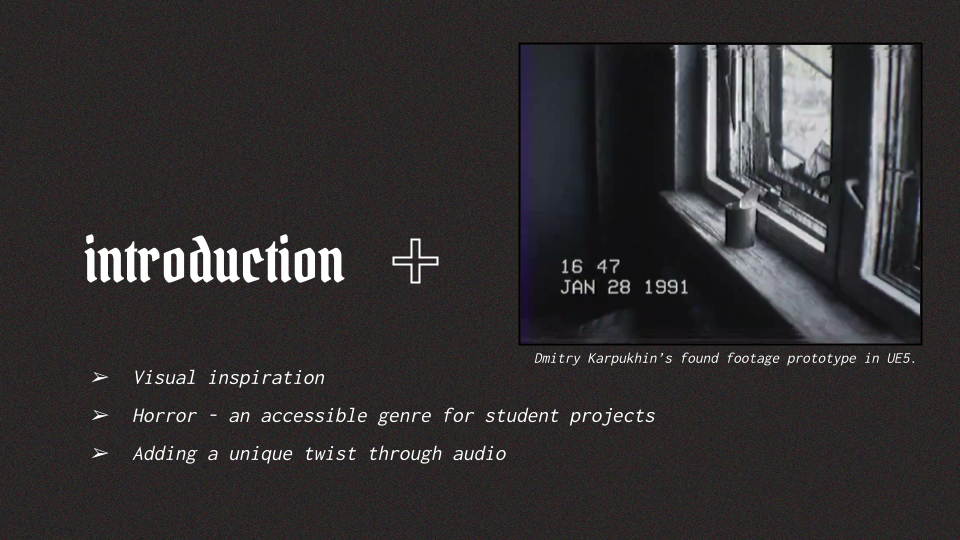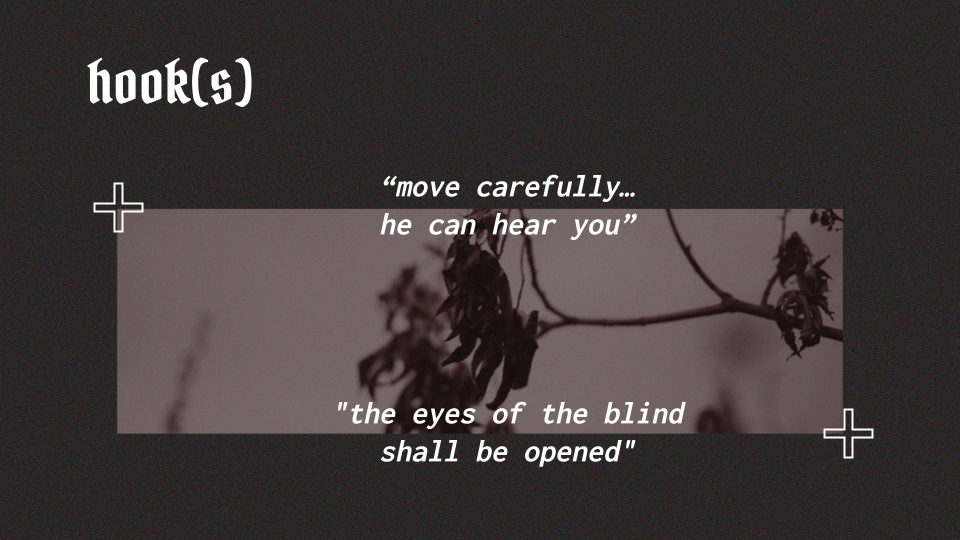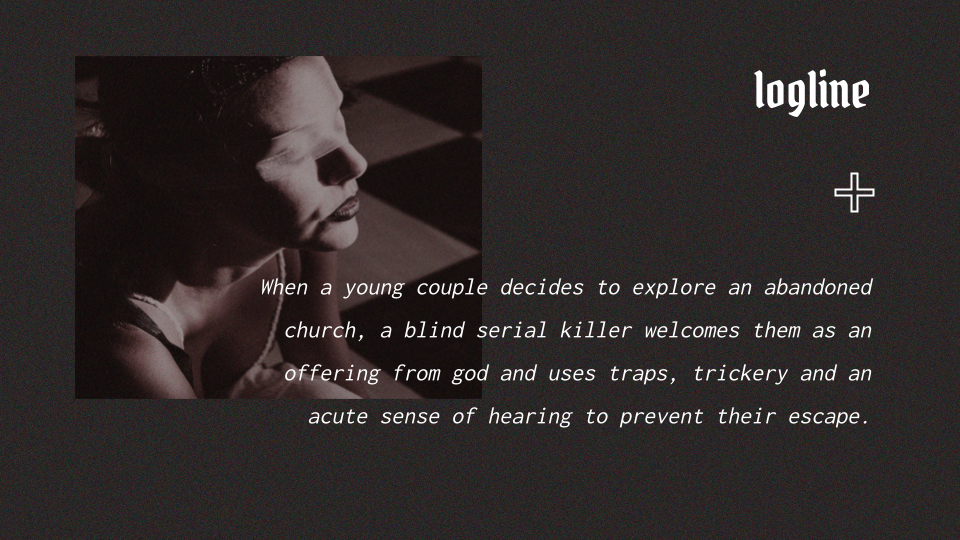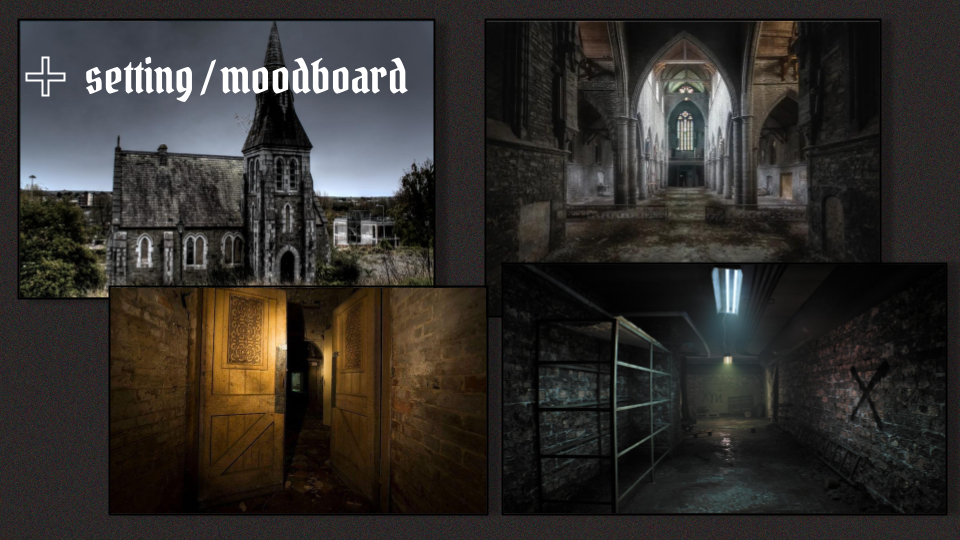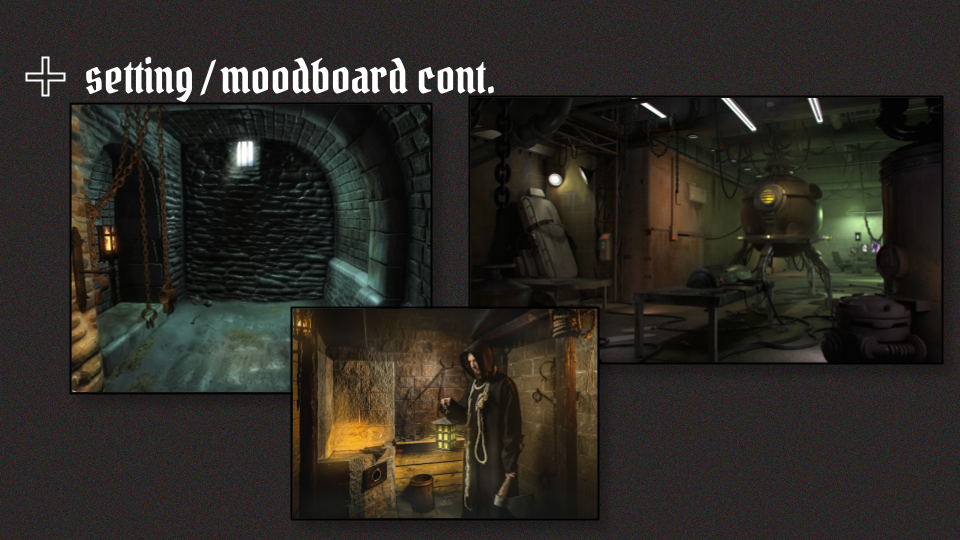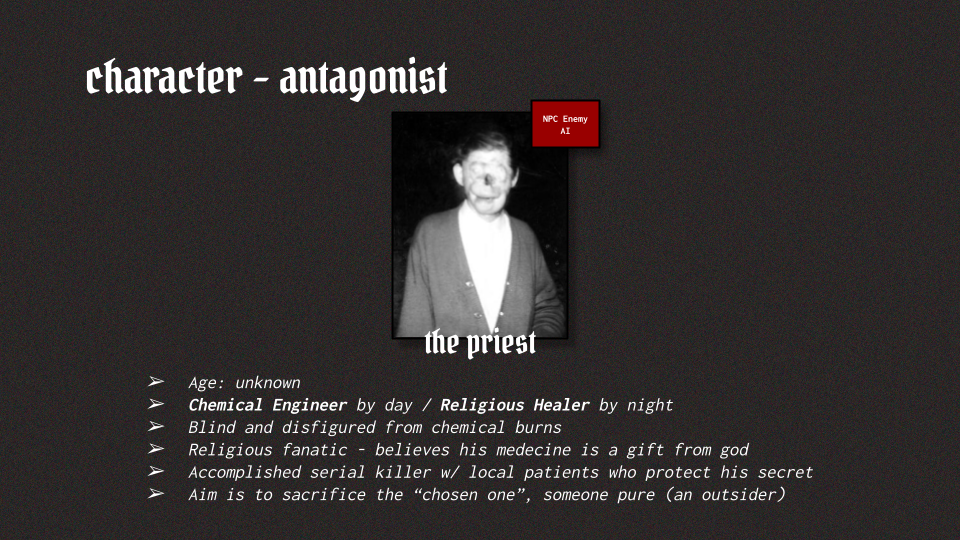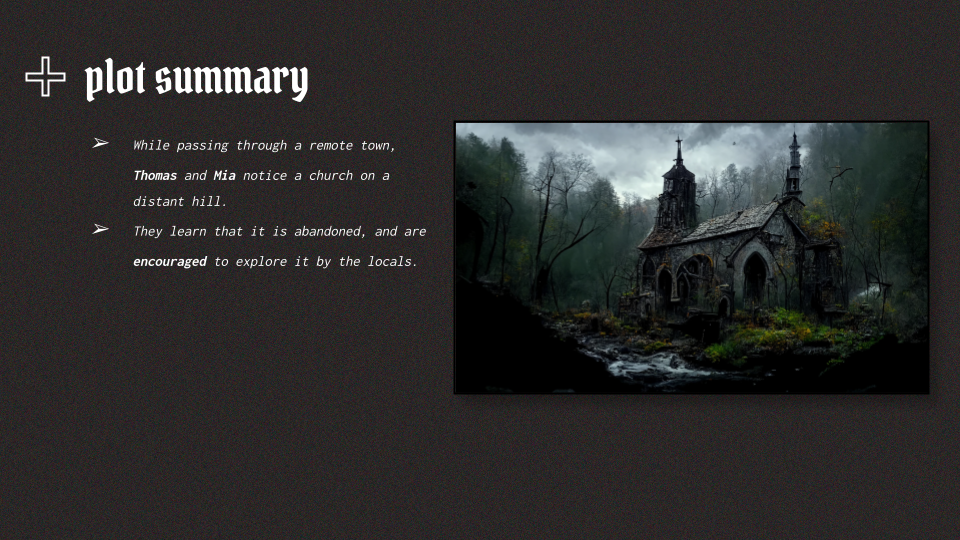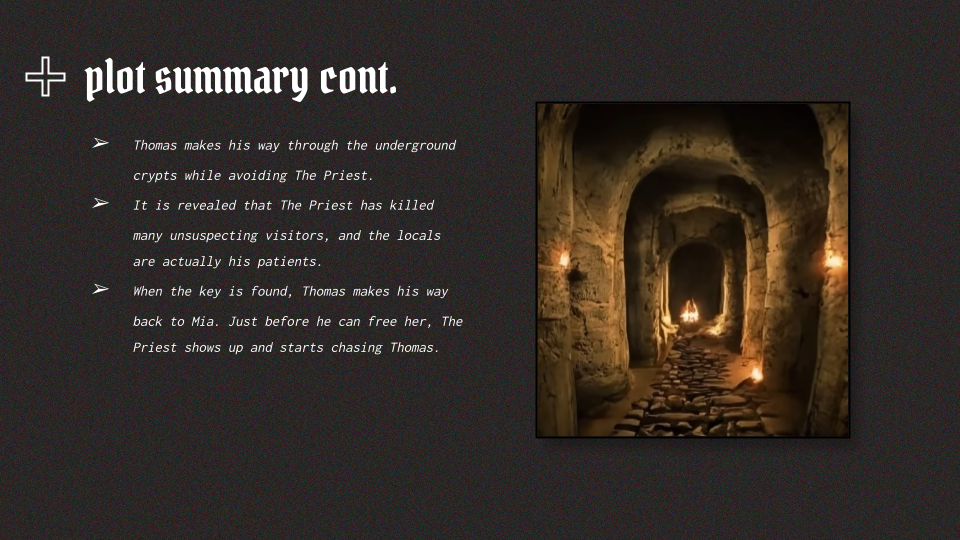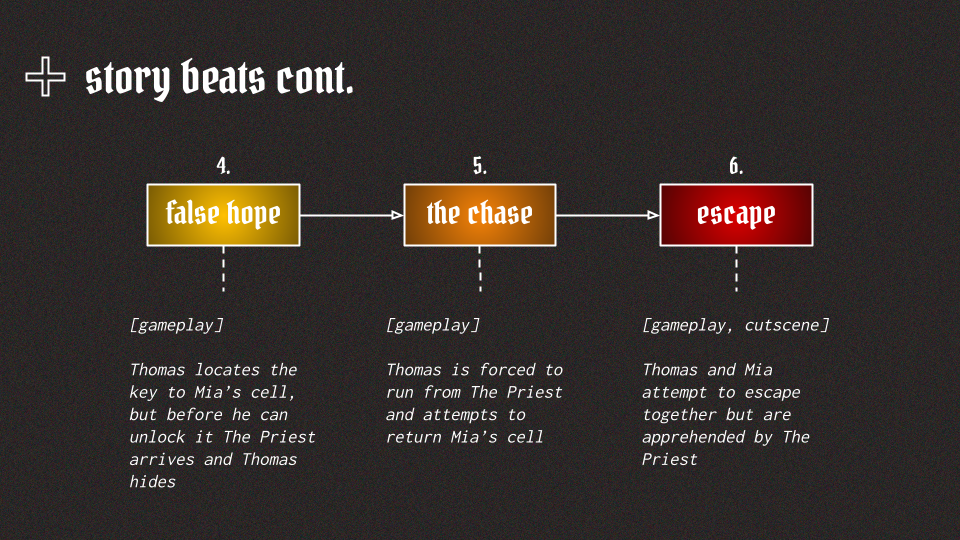
MARTYR
A first-person survival horror game inspired by Outlast. It features two unique level spaces (The Sewer & The Crypt) and an AI enemy (The Priest), hell-bent on preventing your escape.
MY ROLE
Level Design, Blockout, Game Design, Cinematics, SFX
TIMELINE
3 months, Academic Project
TOOLS
Unreal Engine 5, Maya, Reaper
PRE-PRODUCTION
THE PITCH
I created this deck for a 10 minute pitch in our Narrative Design class.
It proved to be a valuable reference point for the team which aligned our collective understanding of the direction of the game.
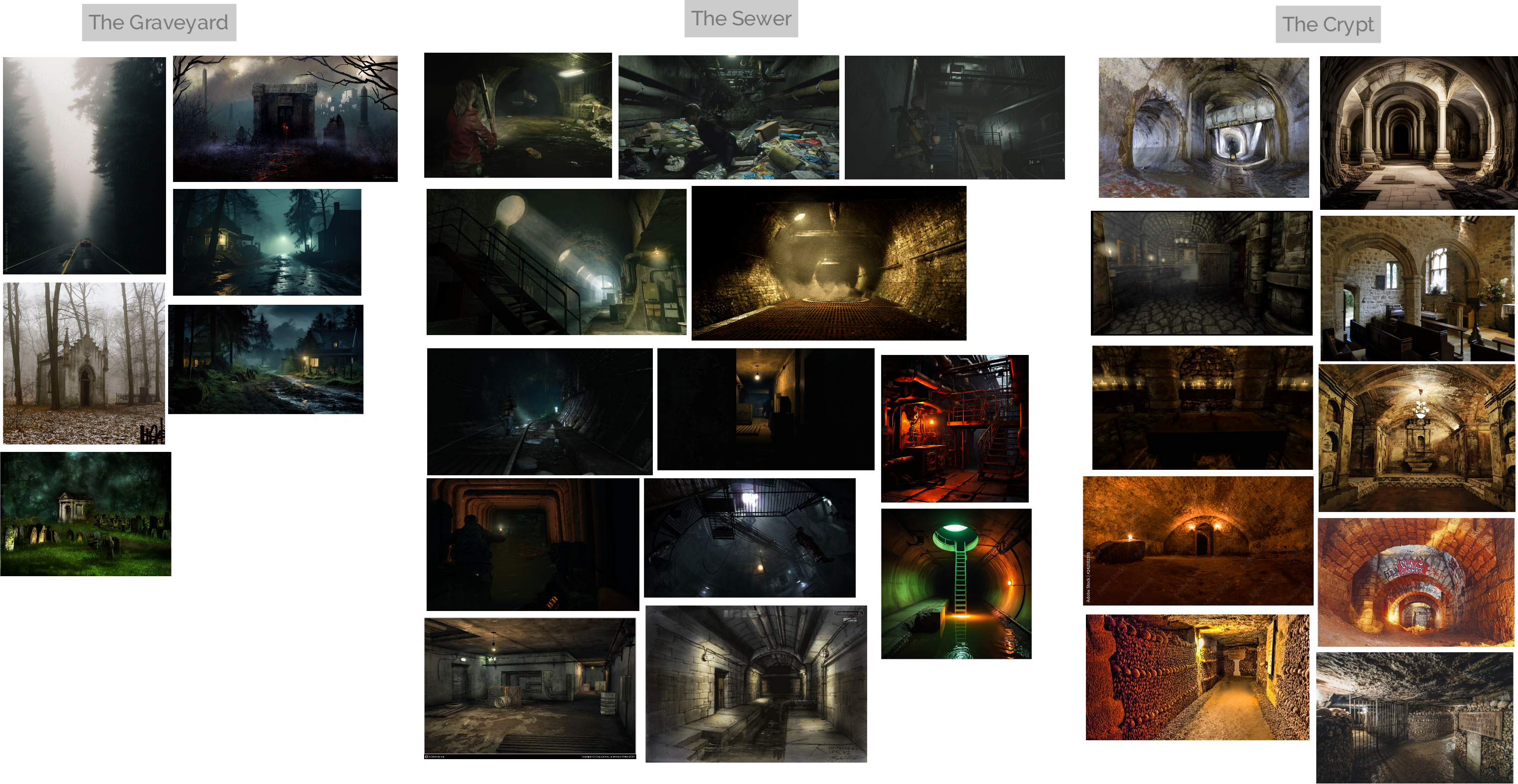
GATHERING REFERENCES
Any material, from images, videos and even music were gathered very early to both use as reference and inspire the team.
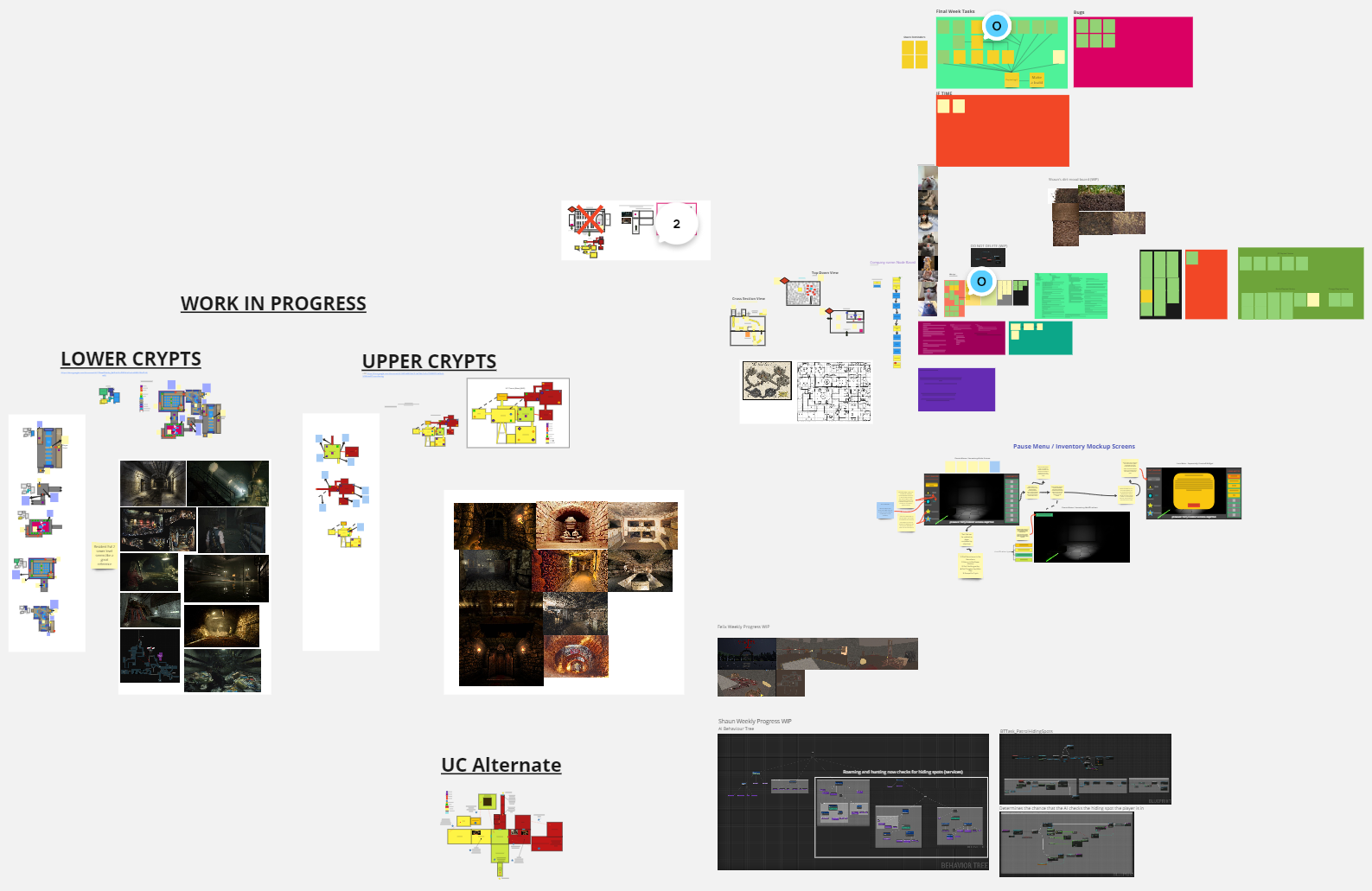
COLLABORATIVE IDEATION
Miro served as our team's virtual "whiteboard." We used it to brainstorm the initial mechanics for our game and set priorities from high to low for their implementation.
Each day we began by pulling up Miro, syncing on our individual progress, and sometimes re-prioritizing the sticky notes (chunks of work).
As production began and bugs began appearing, we moved into a Jira project and kept Miro for quick brainstorming sessions.
LEVEL DESIGN PILLARS
Options
During encounters with The Priest, players should feel as though they have a multitude of options available to avoid and/or escape the threat.


Make high intensity moments more impactful by pacing the experience with relatively low intensity breaks in the action. Finish on a memorable high to leave the player wanting more.
Roller Coaster
Rat
Levels should make the player feel like a rat in a maze, infiltrating someplace they shouldn't be, drowning/desperate, being hunted by a predator with home-field advantage.

LEVEL PLANNING
LEVEL BEATS
Introduction cutscenes
Enter the cemetery crypt/captured!
Enter the sewer



Find the flashlight in the sewer
Enter the sewer basement


Escape the priest

Enter the crypt
Find the basement key
Enter the basement/flashlight dies



Find Mia's cell key
Free Mia/outro cutscene


THE SEWER
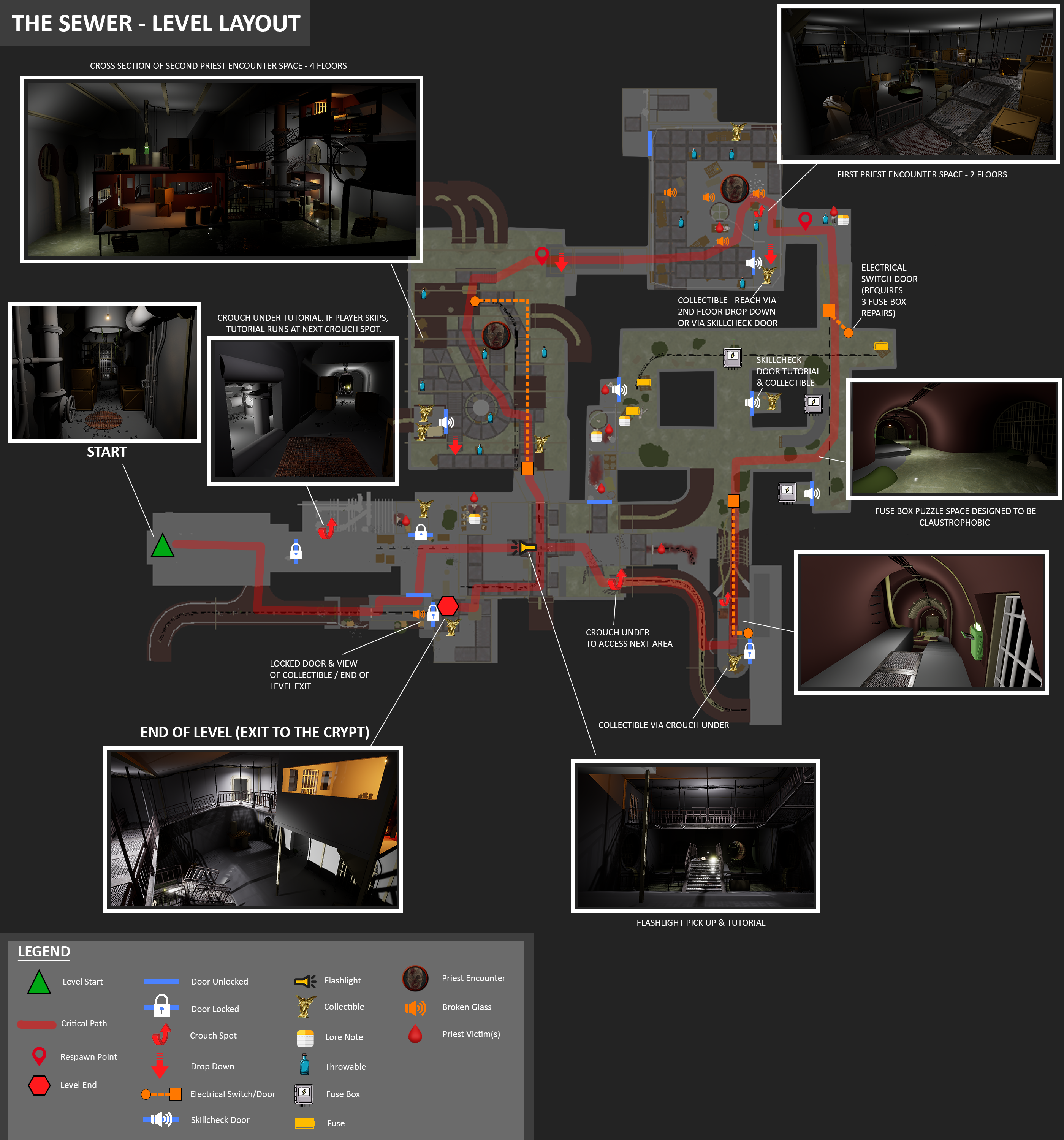
My goal with the Sewer was to gradually introduce our gameplay mechanics in a way that afforded the player time to gain familiarity and comfortability with them in relatively low intensity areas.
Click to enlarge
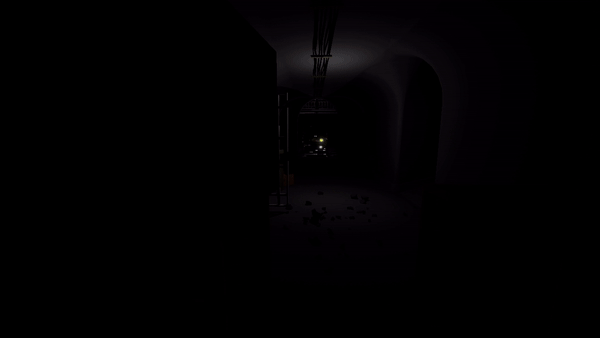
FRAMING THE OBJECTIVE
Finding a flashlight is the player's first objective. An experienced player could manage without, but a first-time player would struggle. Therefore, it needed to be prominently placed in order to not be missed.
I framed it using a long corridor (the flashlight is visible from the level start spawn location) as well as the the arched doorway entrance into the flashlight room.
I also raised it to eye level using a main floor catwalk, and framed it further by placing the second level catwalk directly above it.
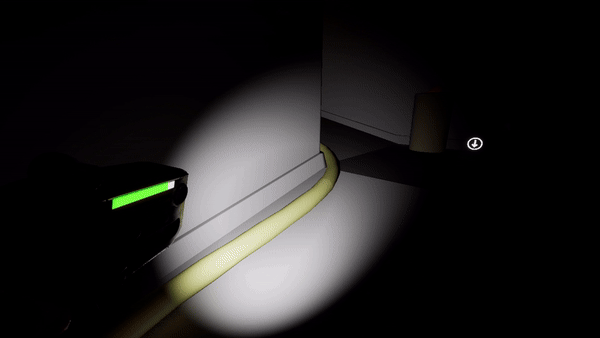
LEADING THE PLAYER
During playtesting, I noticed that the exit from the first Priest encounter wasn't readable and often missed by the player.
I added a leading line in the form of a brightly coloured sewage pipe that snakes through the exit door.
I made sure that it was visible from the safe "observation" zone so that the player could identify it before engaging with the Priest.

BUILDING ANTICIPATION
On multiple occasions, I forced the player to crouch in order to progress. This created the feeling of entering a restricted or dangerous area.
As well, I strategically utilized clusters of mangled corpses and blood trails to increase the foreboding vibe.
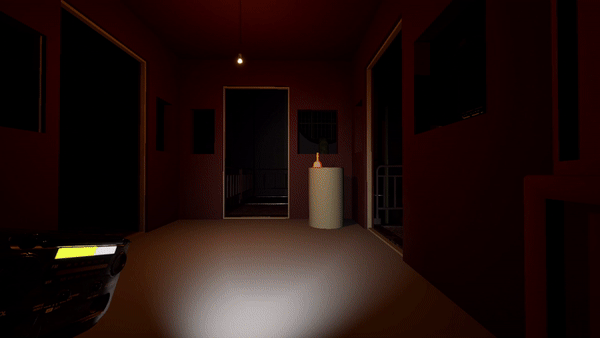
PUZZLE & PROBLEM SOLVING
Mark Brown of Game Maker's Toolkit compares these techniques in his video from 2015.
The electrical switches which open doors, and the fuse box puzzle which requires 3 fuse boxes to be repaired before the switch is operational, are classic single-solution puzzle solving.
The player's interaction with the Priest is more in the realm of problem solving. I designed the Priest encounter spaces to empower the player to be creative in using and combining the solutions available (create noise to distract, numerous routes of escape, etc.).
THE CRYPT
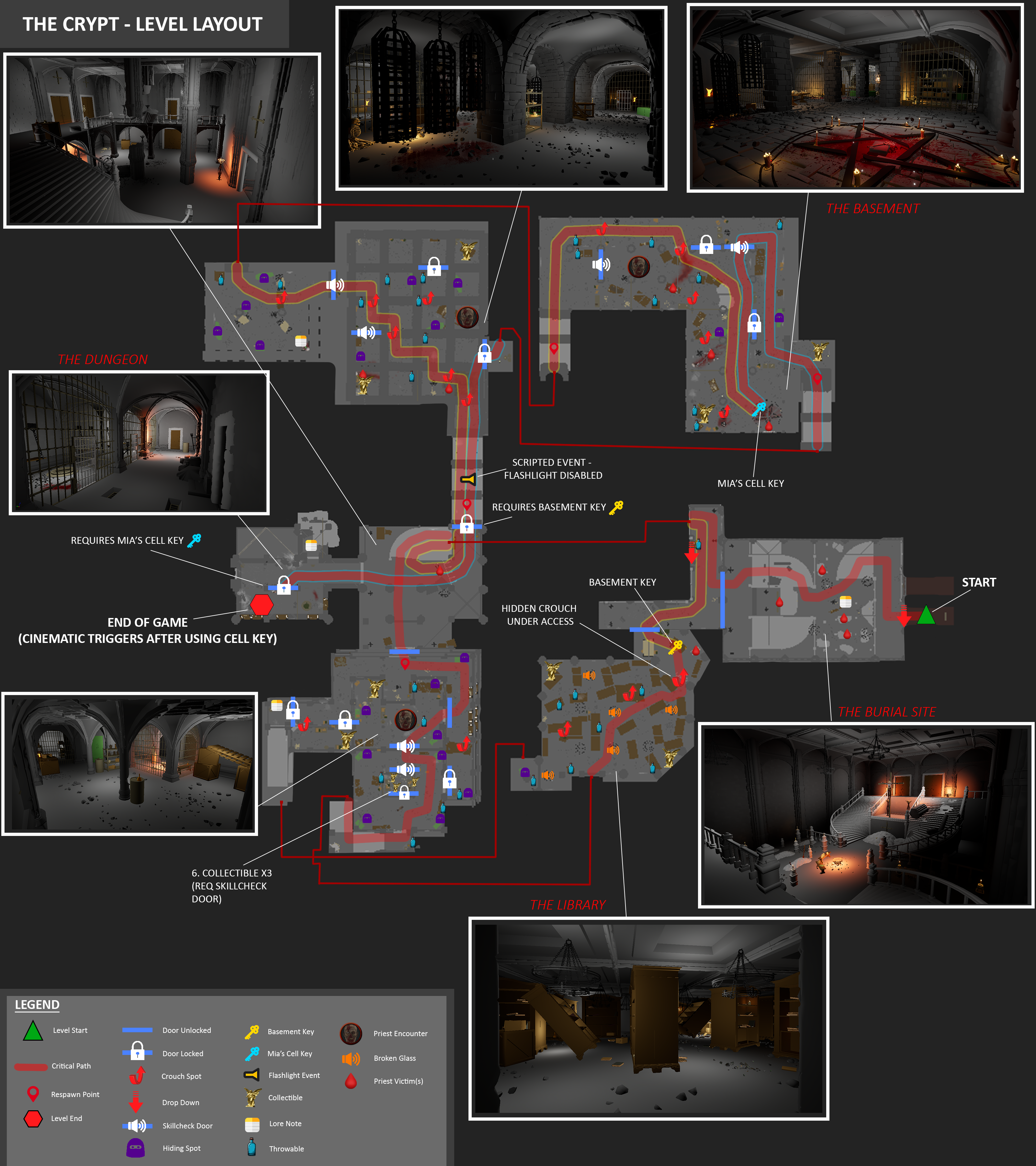
My goal with the Crypt was to reinforce the learned mechanics by utilizing them in progressively more challenging, close-quarters layouts.
Click to enlarge
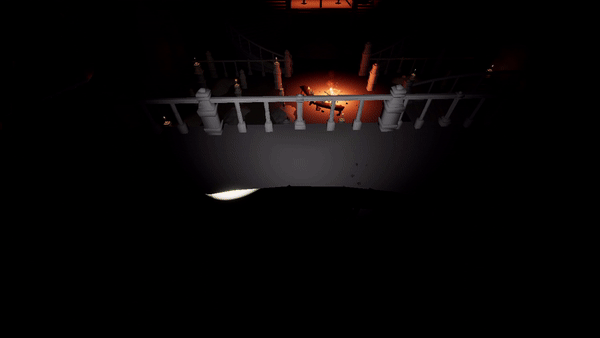
REWARDING THE PLAYER
After completing the Sewer, I reward the player with a vista as they enter the first zone of the Crypt.
The vista is a "grand entrance" leading into the hub of the Crypt level.
It also serves to moderate the intensity of the experience instead of immediately starting another encounter with the Priest.
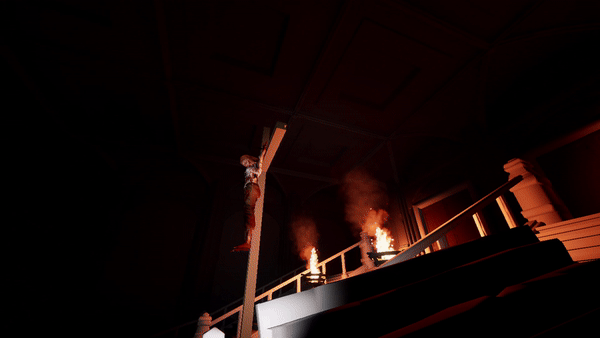
MANAGING INTENSITY
I used a hub and spoke layout for the Crypt level.
The hub is not accessible by the Priest and therefore serves as a safe zone for the player between encounters.
We teleport the Priest to each spoke when the player enters that area in order to guarantee an encounter.
Being able to unload a spoke after completion greatly improved performance.

SUBVERTING PLAYER EXPECTATIONS
The player should be surprised when their most trusted asset, the handcrank flashlight, simply stops working at the "critical moment" as they enter the Basement to find Mia's cell key.
Soon after, the Priest appears wielding a flaming torch.
This was a design decision I made to subvert expectations and amplify the climax of the game.
It forces the player to adapt a new play style where they need to get close to the Priest for navigational purposes.
SCRIPTING AND OTHER CONTRIBUTIONS

HANDCRANK FLASHLIGHT
I did all of the work related to the handcrank flashlight.
Picking it up uses Advanced Locomotion System V4's held object functionality.
Balancing the battery charge and drain speed required revisiting as the levels were being built. It required an understanding of how fast the player could realistically navigate each area, and how often we wanted them to charge up and potentially draw aggro from the Priest.

SKILLCHECK DOOR QUICK TIME EVENT
I scripted this QTE in about an hour during a game design class where we were prototyping mini game ideas using widget blueprints.
Inspired by Dead by Daylight's skillcheck mechanic, when the player fails, a sound is made and the Priest (if within hearing range) is notified to investigate.
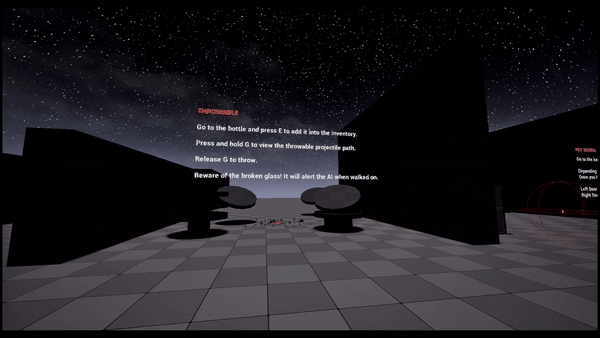
BROKEN GLASS
After Félix completed the foundation of the throwable system, I jumped in and added the broken glass functionality.
The throwable does a line trace to detect the nearest floor mesh, upon which it spawns a broken glass actor which selects a random glass chunk mesh via the construction script.
The broken glass actor was then utilized on its own as a trap which alerts the Priest in addition to acting as a "self-trap" for players who spam throwables.

CINEMATICS
I designed and implemented all of the cinematics except the scene in the restaurant/bar.
I strived to make them impactful "bookends" at the start and end of the game.
It was my first time working with the UE sequencer, and I feel much more confident about using it in future projects.
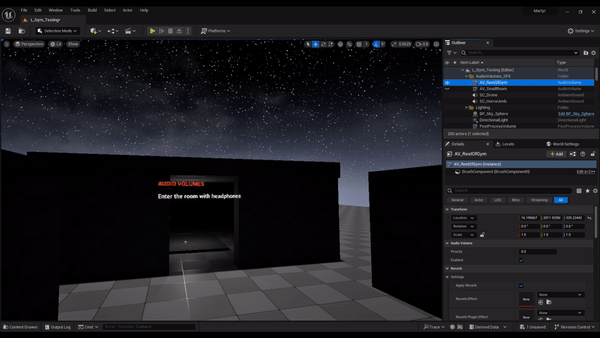
SFX
I sourced, edited, and implemented all of the SFX and music heard throughout the game.
I wish I had more time for this. Sound was an essential part of our game which I worked on throughout the development process.
As new mechanics were implemented, I was adding sounds to give them punch. More time would've meant even more impactful sound usage.
I used Audio Volumes to blend between looping ambient tracks
and add reverb to cavernous spaces
REFLECTIONS
This game was a lot of fun to work on. Having a team that was aligned and enthusiastic from the outset enabled us to make decisions efficiently and iterate based on our own experiences while playtesting.
If I were to start the project again, I would:
-
Re-prioritize the addition of certain mechanics to the game
-
One example is the throwable. It effectively operates as a “cheese” to instantly distract the Priest during a chase. In a way, it works against the usage of hiding spots while being chased, which also required time to get running properly.
-
In short, it feels as though we tried adding more mechanics than perhaps were necessary given the length of the game.
-
-
Focus on building atmosphere with more jump scares and environmental events
-
With more time, I would've added additional level “events” which I feel add a lot of personality and flavour.
-
Perhaps a victim of the Priest is dying and you interact with them in their final moments. It would’ve added tension and the feeling of a larger world that exists beyond the confines of our claustrophobic underground levels.
-


